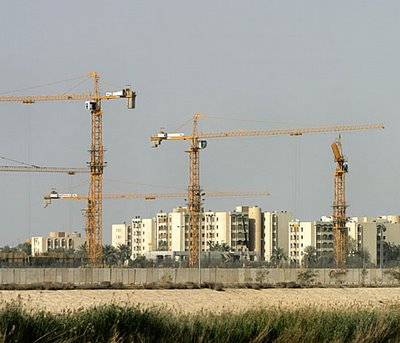 Aric Chen resurfaces (after his departure from the Architect's Newspaper gossip column) in today's Times with a piece on John Portman and his many super-hotels. I must confess a certain awe/admiration for Portman's spaces -- on more than one occasion, I have wandered around the Marriot Marquis in Times Square just for the hell of it, watching those retro-round elevator pods shoot up into the impossible atrium/void. In this respect, I definitely sympathize with Koolhaas's simultaneous contempt and fascination with Portman's hotels -- and I think his suggestion in S,M,L,XL of the isomorphism between Portman's voided hotels and the decentered nature of Atlanta offers quite a strong critique of both. (Yet I should note that I think the true source of Koolhaas's admiration of Portman is not the architecture, but rather the megolomania.) Of course, Koolhaas was not the first to appropriate Portman as a symptom of broader cultural developments; Fredric Jameson's seminal 1984 article "Postmodernism, or The Cultural Logic of Late Capitalism" introduced Portman's Bonaventure Hotel in L.A. as the archetypal "postmodern hyperspace," with its "milling confusion" of the bewildering atrium, elevators, escalators, and aimless wanderers. Chen hints at the Jameson text when he mentions the labyrinthine, disorienting nature of Portman's spaces, but mostly his commentary presents a watered-down interpretation of Portman's architecture, with lines like the following: " Their cylindrical tinted-glass towers sparkled atop concrete podiums, while inside, ficus-filled Xanadus of flying walkways, spiraling stairs and cantilevered terraces were waiting to be discovered — an ideal habitat for the modern nomad in search of a well-garnished cocktail." Surely there's more to modern nomadism, and more at stake in Portman's hotels, then the quest for booze? Too bad Chen didn't delve deeper... but then again, it's just a Travel section article.
Aric Chen resurfaces (after his departure from the Architect's Newspaper gossip column) in today's Times with a piece on John Portman and his many super-hotels. I must confess a certain awe/admiration for Portman's spaces -- on more than one occasion, I have wandered around the Marriot Marquis in Times Square just for the hell of it, watching those retro-round elevator pods shoot up into the impossible atrium/void. In this respect, I definitely sympathize with Koolhaas's simultaneous contempt and fascination with Portman's hotels -- and I think his suggestion in S,M,L,XL of the isomorphism between Portman's voided hotels and the decentered nature of Atlanta offers quite a strong critique of both. (Yet I should note that I think the true source of Koolhaas's admiration of Portman is not the architecture, but rather the megolomania.) Of course, Koolhaas was not the first to appropriate Portman as a symptom of broader cultural developments; Fredric Jameson's seminal 1984 article "Postmodernism, or The Cultural Logic of Late Capitalism" introduced Portman's Bonaventure Hotel in L.A. as the archetypal "postmodern hyperspace," with its "milling confusion" of the bewildering atrium, elevators, escalators, and aimless wanderers. Chen hints at the Jameson text when he mentions the labyrinthine, disorienting nature of Portman's spaces, but mostly his commentary presents a watered-down interpretation of Portman's architecture, with lines like the following: " Their cylindrical tinted-glass towers sparkled atop concrete podiums, while inside, ficus-filled Xanadus of flying walkways, spiraling stairs and cantilevered terraces were waiting to be discovered — an ideal habitat for the modern nomad in search of a well-garnished cocktail." Surely there's more to modern nomadism, and more at stake in Portman's hotels, then the quest for booze? Too bad Chen didn't delve deeper... but then again, it's just a Travel section article.
link: "The Kubla Khan of Hotels" by Aric Chen, in the New York Times
 David Childs and SOM just revealed the updated design for the Freedom Tower. Seems they've converted an oppressive 187 ft. metal-covered concrete base to an oppressive 187 ft. glass-covered concrete base. Brilliant.
David Childs and SOM just revealed the updated design for the Freedom Tower. Seems they've converted an oppressive 187 ft. metal-covered concrete base to an oppressive 187 ft. glass-covered concrete base. Brilliant.






